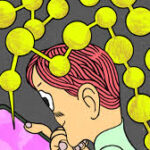Now Reading: Understanding Autistic Newborn Signs: Early Clues for Parents
-
01
Understanding Autistic Newborn Signs: Early Clues for Parents
Understanding Autistic Newborn Signs: Early Clues for Parents

Welcoming a newborn into your life is a journey filled with joy, love, and a lot of learning. As a new parent, you pay close attention to every little sound, movement, and expression your baby makes. It’s natural to have questions about your child’s development. One topic that many parents wonder about is autism. While a formal diagnosis of autism spectrum disorder (ASD) typically happens much later, some parents look for early clues. This guide will walk you through what experts say about potential autistic newborn signs, focusing on what is observable in the first few months of life. We’ll explore developmental milestones and offer guidance on what to do if you have concerns.
Key Takeaways
- No Definitive Signs: There are no definitive autistic newborn signs that can confirm a diagnosis. Autism is typically diagnosed in toddlerhood or later.
- Focus on Developmental Patterns: Instead of looking for a single sign, it’s more helpful to observe patterns in your baby’s social communication, sensory responses, and motor skills over time.
- Early Intervention is Key: Recognizing developmental differences early on can lead to support that makes a significant positive impact on a child’s long-term growth.
- Trust Your Instincts: As a parent, you know your child best. If you have concerns, it’s always best to speak with a pediatrician or a child development specialist.
Can You Spot Autistic Newborn Signs?
This is the big question for many concerned parents. The straightforward answer is that it’s not possible to diagnose autism in a newborn. The diagnostic criteria for autism spectrum disorder are based on patterns of behavior in social communication, interaction, and restricted or repetitive behaviors that become more apparent as a child grows. Newborns are still in the earliest stages of development, and their behaviors are largely reflexive.
However, research is exploring very early developmental markers that might be associated with a higher likelihood of an autism diagnosis later in life. These are not definitive autistic newborn signs, but rather subtle differences in development that some studies have noted. It’s important for parents to understand that many babies who show these early differences do not go on to be diagnosed with autism. Conversely, some children with autism may not have shown any noticeable signs as newborns. The goal is not to create anxiety but to empower parents with information about typical and atypical development.
Understanding Early Social and Communication Milestones
From the moment they are born, babies are wired to connect. They learn about the world through their interactions with you. Observing how your newborn engages with their environment can provide clues about their early social development.
The Importance of Eye Contact
One of the earliest ways babies connect is through eye contact. By six to eight weeks, most infants begin to make brief but intentional eye contact with their caregivers. This is a foundational skill for social bonding and communication. Some retrospective studies, where parents of autistic children recall their infancy, have noted a lack of sustained eye contact.
However, it’s crucial to remember that a newborn’s ability to focus is still developing. They might look at your hairline or eyebrows instead of directly into your eyes. A baby might also be tired, overstimulated, or simply more interested in a ceiling fan at that moment. A lack of consistent eye contact in the first couple of months is not a definitive sign of anything on its own. It is the pattern over time that matters more.
Responding to Sounds and Voices
Your voice is one of the first sounds your baby recognizes. Even as newborns, babies can show a preference for their mother’s voice and may turn their heads toward a familiar sound. They might startle at loud noises or calm down when they hear a soft, soothing voice. This response to auditory stimuli is a key part of early interaction.
If you are looking for potential autistic newborn signs, you might wonder about your baby’s reaction to sound. Some parents of autistic children later report that their infants seemed less responsive to their name or to the sound of voices. On the other hand, some babies might seem overly sensitive to everyday noises. It’s a delicate balance, and variations are normal.
Motor Development and Sensory Responses
How a baby moves and reacts to the world around them is another window into their development. Motor skills and sensory processing are deeply connected to how a child learns to interact and communicate.
Observing Newborn Motor Skills
Newborns have a set of reflexes like rooting and sucking. As they grow over the first few months, these reflexes fade, and more voluntary movements take over. They begin to gain head control, bring their hands to their mouth, and start to push up when lying on their tummy.
Some research suggests that subtle differences in motor development may be linked to a later autism diagnosis. This could include things like having low muscle tone (feeling “floppy”) or having unusually stiff arms and legs. A preference for using one side of the body over the other very early on can also be a developmental flag, though not specifically for autism. These are details your pediatrician will check during well-baby visits.
How Babies Process Sensory Information
Every baby has unique sensory preferences. Some love to be swaddled tightly, while others prefer more freedom. Some are easily overstimulated by lights and sounds, while others seem to crave more sensory input. This is all part of their individual temperament.
Difficulties with sensory processing are a core feature of autism. In a newborn, this can be very hard to distinguish from normal infant fussiness. However, extreme and consistent reactions could be worth noting. For example, a baby who is constantly distressed by gentle touch or who seems completely unaware of sensations like being wet or cold could have differences in sensory processing. These patterns are more meaningful when they persist over many months.
A Realistic Guide to Developmental Milestones
Tracking milestones is a helpful way to understand your baby’s progress. However, it’s important to view these as a general guide, not a strict checklist. Development is not a race.
Typical Developmental Timeline: 0-3 Months
Here is a table outlining some typical milestones for the first few months. Remember, every baby develops at their own pace.
|
Age |
Social/Emotional Milestones |
Communication Milestones |
Motor Milestones |
|---|---|---|---|
|
1 Month |
Can briefly calm self. Begins to look at faces. |
Makes gurgling sounds. Cries for needs. |
Brings hands near face. Moves head side to side. |
|
2 Months |
Begins to smile at people. Tries to look at parents. |
Coos and makes gurgles. Turns head toward sounds. |
Can hold head up. Makes smoother movements. |
|
3 Months |
Smiles socially. Enjoys playing with people. |
Babbles and imitates sounds. |
Can support upper body with arms on tummy. |
Viewing a wide range of information can be helpful, and some publications like those on https://forbesplanet.co.uk/ offer diverse perspectives on health and wellness topics that parents may find interesting.
What to Do If You Have Concerns
It is completely normal to worry about your child’s health and development. Your parental intuition is a powerful tool. If something feels off to you, it is always worth exploring.
The Role of Your Pediatrician
Your child’s pediatrician is your primary partner in monitoring their development. Regular well-baby checkups are designed to screen for developmental delays. Your doctor will ask you questions about what you’re observing at home and will perform a physical exam.
Be open and honest about your concerns. It can be helpful to keep a journal of your observations. For example, instead of just saying “I’m worried about autistic newborn signs,” you could provide specific examples: “I’ve noticed he rarely looks at my face when I feed him,” or “She gets extremely upset by the sound of the vacuum cleaner, even from another room.” This specific information gives your doctor a clearer picture.
Early Intervention Services
If your pediatrician shares your concerns or identifies a potential developmental delay, they may recommend a referral to an early intervention program. These programs are available in every state in the US and provide services for children from birth to age three who have developmental delays or disabilities.
Early intervention is not an autism diagnosis. It is a system of support designed to help your child develop skills and reach their full potential. Services can include physical therapy, occupational therapy, and speech therapy. The goal is to provide support as early as possible, because the first few years of life are a critical period for brain development. Getting help early can make a world of difference.
A Look Ahead: Signs in Older Babies and Toddlers
While it is difficult to identify autistic newborn signs, the picture becomes clearer as a child gets older. The signs of autism are more recognizable between 12 and 24 months.
These may include:
- Not responding to their name by 12 months.
- Not pointing at objects to show interest by 14 months.
- Not playing “pretend” games by 18 months.
- Avoiding eye contact and wanting to be alone.
- Repeating words or phrases over and over (echolalia).
- Getting upset by minor changes in routine.
- Having obsessive interests.
- Flapping their hands, rocking their body, or spinning in circles.
If you notice a consistent pattern of these behaviors in your toddler, it is important to seek a formal developmental evaluation.
Conclusion
The journey of parenthood is one of discovery, and every child’s path is unique. While the concept of autistic newborn signs is a subject of ongoing research, it’s clear that there is no single behavior in the first few months of life that can predict or diagnose autism. The most effective approach for parents is to focus on the big picture of development. Celebrate your baby’s small achievements, learn their unique personality, and build a strong, loving bond.
Stay informed about typical developmental milestones, but avoid becoming overly anxious about any single behavior. Trust your instincts. If you feel a persistent concern about your baby’s development, share your specific observations with your pediatrician. Early support and intervention are powerful tools that can help every child thrive. Remember, you are your child’s best advocate, and your love and attention are the most important things you can give them.
Frequently Asked Questions (FAQ)
1. Can a baby be diagnosed with autism at 2 months old?
No, a baby cannot be diagnosed with autism at 2 months old. The diagnostic process requires observing a pattern of social communication and behavioral traits that are not yet developed in a newborn. Diagnosis typically occurs in toddlerhood, usually after 18 months of age.
2. Is lack of smiling a sign of autism in a newborn?
Most babies begin social smiling around two months of age. If a baby isn’t smiling by three months, it can be a sign of a developmental delay, but it is not specifically a sign of autism. It’s a point to discuss with your pediatrician, who can assess it in the context of overall development.
3. Do all autistic children show signs as newborns?
No. Many parents of autistic children report that their child’s development seemed typical during the first year of life. Some children experience a “regression,” where they lose previously acquired skills. The presentation of autism varies greatly from one individual to another.
4. What is the most important thing I can do if I’m worried?
The most important thing you can do is talk to a professional. Schedule an appointment with your child’s pediatrician to discuss your specific concerns. Early screening and access to early intervention services are key to supporting your child’s development.
5. How can I support my newborn’s social development?
You can support your newborn’s development by being responsive and engaged. Make eye contact, smile, talk, and sing to your baby. Respond to their coos and cries. Give them tummy time to build strength. These simple, loving interactions are the building blocks of communication and social bonding.

















